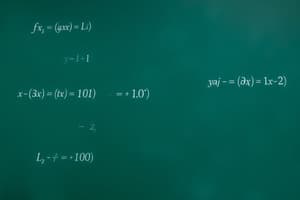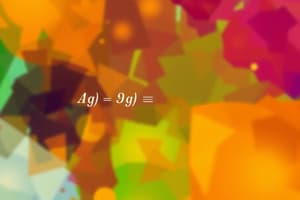Podcast
Questions and Answers
What is the domain of the function represented as (-4,-2)∪(-2,2)∪(2,∞)?
What is the domain of the function represented as (-4,-2)∪(-2,2)∪(2,∞)?
- (-∞,∞)
- All real numbers
- (-4,-2)∪(-2,2)∪(2,∞) (correct)
- (-∞,-2)∪(-2,∞)
What is the domain of the function that includes all real numbers?
What is the domain of the function that includes all real numbers?
- (-∞,∞)
- All real numbers (correct)
- (4,∞)
- x ≠ 4
What is the domain of the function represented as (-∞,-2)∪(-2,∞)?
What is the domain of the function represented as (-∞,-2)∪(-2,∞)?
- (2,∞)
- (-2,∞)
- (-∞,-2)∪(-2,∞) (correct)
- (-∞,-2)
What is the domain when the condition is x ≠ 4?
What is the domain when the condition is x ≠ 4?
What is the domain represented as (-∞,-4)∪(-4,4)∪(4,∞)?
What is the domain represented as (-∞,-4)∪(-4,4)∪(4,∞)?
What is the domain when the conditions are x ≠ 4 and x ≠ 0?
What is the domain when the conditions are x ≠ 4 and x ≠ 0?
What is the domain when the conditions are x ≠ 0 and x ≠ 2?
What is the domain when the conditions are x ≠ 0 and x ≠ 2?
What is the domain represented by x ≥ 4?
What is the domain represented by x ≥ 4?
What is the domain represented by (4,∞)?
What is the domain represented by (4,∞)?
What is the domain represented by [2,∞)?
What is the domain represented by [2,∞)?
What is the domain represented by (2,∞)?
What is the domain represented by (2,∞)?
What is the domain with the conditions x ≠ √2 and x ≠ -√2?
What is the domain with the conditions x ≠ √2 and x ≠ -√2?
What is the domain represented as [-3,2)∪(2,∞)?
What is the domain represented as [-3,2)∪(2,∞)?
What is the domain represented as (-∞,-2]?
What is the domain represented as (-∞,-2]?
What is the domain represented as (-∞,∞)?
What is the domain represented as (-∞,∞)?
What is the domain represented by [4,∞)?
What is the domain represented by [4,∞)?
Flashcards are hidden until you start studying
Study Notes
Domains of Functions
-
The domain defined as (-4, -2)∪(-2, 2)∪(2, ∞) indicates that the function is valid for all real numbers except for -2, where it is not defined.
-
A function with a domain of all real numbers is valid for every possible input without restriction.
-
The domain (-∞, -2)∪(-2, ∞) allows for all real numbers except -2, showing no restrictions on both sides of -2.
-
If the domain is stated as x ≠ 4, that means the function is defined for all real numbers except for the specific value of 4.
-
A domain defined as (-∞, -4)∪(-4, 4)∪(4, ∞) reflects that all values are allowed except for -4 and 4.
-
The domain x ≠ 4, x ≠ 0 specifies that the function is defined for all real numbers except for the values 4 and 0.
-
When the domain is given as x ≠ 0, x ≠ 2, the function is valid for all real numbers except for 0 and 2.
-
A domain of x ≥ 4 means the function accepts inputs starting from 4 and extending to positive infinity.
-
The domain (4, ∞) indicates that the function is valid for all values greater than 4, not inclusive of 4 itself.
-
A domain of [2, ∞) includes 2 and all real numbers greater than 2, indicating that 2 is a valid input.
-
The domain (2, ∞) specifies that the function is valid for all values strictly greater than 2, excluding 2.
-
If the domain is defined as x ≠ √2, x ≠ -√2, the function is valid for all real numbers except for the square root of 2 and its negative.
-
The domain [-3, 2)∪(2, ∞) allows numbers between -3 and 2, including -3 but excluding 2, and includes all numbers greater than 2.
-
A domain of (-∞, -2] indicates that all values up to and including -2 are valid, while values greater than -2 are not included.
-
The domain (-∞, ∞) is the broadest, indicating the function is defined for all real numbers without any restrictions.
-
The domain [4, ∞) allows for 4 and any higher values, including all positives beyond 4.
Studying That Suits You
Use AI to generate personalized quizzes and flashcards to suit your learning preferences.




